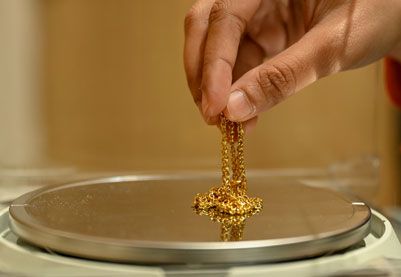Will Gold Rates in India Decrease in Coming Days
Why is the gold price falling: Understanding the current trend
If you have been wondering “will gold rate decrease?” or “will gold rate decrease in coming days?”, it helps to understand the factors behind the dip. Gold prices are influenced by global economic trends, currency fluctuations, and investor sentiment. Stronger US dollar, rising interest rates, or reduced demand from key markets can make gold prices fall. Occasionally, geopolitical stability or reduced inflation concerns also lead to a drop in demand, prompting questions like “will gold price go down?” or “will gold rate decrease in coming days in India?”. While predicting exact movements is tricky, staying updated with market trends can help you anticipate whether the gold price will drop or if gold rate will decrease soon, helping you make informed buying or investment decisions.
Forecasting a downward trend in gold price trend
Gold prices often move based on global and domestic factors, and many people are now wondering will gold price go down due to recent market signals.
- Strengthening US dollar:
When the dollar gains strength, gold becomes costlier for other countries, reducing demand and possibly pushing prices down. - Rising interest rates:
Higher interest rates make options like bonds and savings more appealing. As investors shift away from gold, prices may soften. If you plan to borrow, always check the current gold loan interest rate. - Improving global economy:
A stable or improving global economy can reduce the need for gold as a safe-haven asset. - Reduced geopolitical tension:
When global uncertainties ease, gold demand can fall, pulling prices lower. - Increased supply:
More mining output or large gold sales by central banks increase supply and may lead to a price decline.
With these factors in mind, some people are asking will gold rate decrease in coming days in India, but since markets change quickly, it is important to stay updated on economic trends and global events.
Forecasting influencing gold rate forecast
When it comes to predicting how gold might move, several global and domestic factors come into play. Many people keep wondering will gold price go down, so they closely follow gold price forecasts to understand whether rates may rise or fall. Global economic conditions, inflation trends, interest rate changes, and the strength of the US dollar are some of the biggest drivers. In India, local demand during festivals and weddings, along with how strong the rupee is, also makes a big difference.
Forecasting gold prices is not just about numbers. It is about connecting economic signals with market behaviour. For example, if inflation goes up, gold becomes more attractive as a safe-haven asset. But when interest rates rise, some people even question will gold prices fall because gold becomes less appealing compared to other investments.
If you are planning to buy gold, invest, or even take a gold loan, staying updated on future trends can really help. Bajaj Finance shares useful insights through its gold price forecast, making it easier to understand market movements. These updates
are handy for anyone tracking whether will gold price drop in the coming months and want to time their purchases or borrowing decisions better.
Curious about your loan eligibility? Enter your mobile number to see how much you can get for your gold.
Domestic triggers for falling gold rates in India
Gold prices in India are not only influenced by global trends but also by domestic factors. Economic growth, inflation trends, and government policies play a key role in shaping local gold rates. When the Indian economy performs well, investors often shift to other assets like equities or real estate, reducing demand for gold and causing prices to drop.
Monetary policies by the Reserve Bank of India, such as changes in interest rates, also impact gold prices. Higher rates make gold less attractive since it does not yield interest, which can lead to falling gold rates.
Additionally, fluctuations in the Indian rupee affect gold imports. A stronger rupee makes imported gold cheaper, which can push domestic prices down. Seasonal demand patterns, such as post-festival periods, may also trigger short-term declines.
Understanding these domestic triggers helps answer questions like will gold rate decrease or will gold price drop in India.
Role of the US Dollar and inflation in gold price trends
The US Dollar plays a key role in determining global gold prices. Gold is priced in dollars internationally, so when the dollar strengthens, gold becomes costlier in other currencies, often slowing demand. Conversely, a weaker dollar can push gold prices higher. Inflation also impacts gold as it is considered a hedge against rising prices. When inflation rises, the purchasing power of currency falls, making gold a more attractive store of value. Investors often turn to gold to protect their wealth, which can increase demand and influence price trends. Monitoring dollar movements and inflation rates helps predict gold price behaviour, enabling informed investment or purchase decisions.
Impact of rupee strength on gold imports
The strength of the Indian rupee directly affects the domestic gold rate. When the rupee strengthens against the US Dollar, importing gold becomes cheaper, potentially lowering local gold prices. Conversely, a weaker rupee makes gold imports costlier, pushing prices up. India imports a significant portion of its gold, so currency fluctuations can significantly impact gold availability and cost. Other factors like global gold trends, import duties, and customs charges also influence final prices. For buyers and investors, understanding the rupee’s strength and its effect on gold imports helps in planning purchases, anticipating price changes, and making timely decisions in the domestic market.
It takes just 2 steps to check your eligibility for a Bajaj Finserv Gold Loan. Enter your mobile number now.
Global factors affecting gold price decline
Gold prices are influenced by various global factors that can cause them to rise or fall. Understanding these elements helps investors anticipate trends and make informed decisions about buying or selling gold.
- Economic stability: When the global economy shows growth or stability, investors may shift to higher-yielding assets, reducing demand for gold, which can cause the gold rate to decrease.
- Interest rates: Rising interest rates increase the opportunity cost of holding gold, leading to potential declines in gold prices.
- US dollar strength: A stronger US dollar makes gold more expensive for buyers using other currencies, often resulting in a drop in demand and a fall in prices.
- Global supply and demand: Increased mining output or lower demand for jewellery and industrial use can reduce gold prices.
- Market speculation: Investor sentiment, trends, and speculative trading can also lead to short-term price drops.
These factors help answer questions like will gold rate decrease in coming days or will gold price go down.
Will the gold rate decrease during the festive season in India?
During the festive season, many people wonder, will gold rate decrease in coming days or will gold price go down? Typically, the demand for gold rises during festivals like Diwali and Dussehra, as families buy jewellery and gifts. Higher demand often keeps prices stable or even pushes them slightly up. However, global market trends, currency fluctuations, and economic factors also play a role, influencing whether the gold rate will decrease or will gold price drop.
If international gold prices fall or the rupee strengthens, there could be small price corrections. Yet, festive demand usually offsets major drops. For anyone planning to buy gold, it is helpful to monitor daily prices, track trends, and stay informed through reliable sources to make smarter purchasing decisions.
Conclusion
While gold is often seen as a stable investment, many people still wonder why is gold price falling when global conditions shift. Factors like a stronger US dollar, economic stability, and increased gold supply can put downward pressure on prices.
These changes help answer another common question: does gold rate decrease when global markets become more stable or interest rates rise?
Understanding these influences is important for anyone tracking gold trends. During periods of falling prices, using your gold through a gold loan can offer financial flexibility, helping you stay prepared despite market uncertainty.
Ready to unlock the value of your gold? Apply for Bajaj Finserv Gold Loan today.
Know more about gold rates in Indian states
Know more about gold rates in other cities
Related Articles
Disclaimer
Bajaj Finance Limited has the sole and absolute discretion, without assigning any reason to accept or reject any application. Terms and conditions apply*.
For customer support, call Personal Loan IVR: 7757 000 000









 Personal Loan
Personal Loan Check Eligibility
Check Eligibility Salaried Personal Loan
Salaried Personal Loan EMI Calculator
EMI Calculator Account Aggregator
Account Aggregator Credit Pulse Report
Credit Pulse Report
 Deals starting @99
Deals starting @99 Min. 50% off
Min. 50% off
 Bajaj Pay
Bajaj Pay Wallet to Bank
Wallet to Bank
 Easy EMI Loan
Easy EMI Loan Savings Offer
Savings Offer Smartphones
Smartphones Led TVs
Led TVs Washing Machines
Washing Machines Laptops
Laptops Refrigerators
Refrigerators Air Conditioner
Air Conditioner Air Coolers
Air Coolers
 Loan Against Shares
Loan Against Shares Loan Against Mutual Funds
Loan Against Mutual Funds Loan Against Insurance Policy
Loan Against Insurance Policy ESOP Financing
ESOP Financing Easy EMI Loan
Easy EMI Loan Two-wheeler Loan
Two-wheeler Loan Loan for Lawyer
Loan for Lawyer Industrial Equipment Finance
Industrial Equipment Finance Industrial Equipment Balance Transfer
Industrial Equipment Balance Transfer Industrial Equipment Refinance
Industrial Equipment Refinance Personal Loan Branch Locator
Personal Loan Branch Locator Used Tractor Loan
Used Tractor Loan Loan Against Tractor
Loan Against Tractor Tractor Loan Balance Transfer
Tractor Loan Balance Transfer Flexi
Flexi View All
View All
 Two-wheeler Loan
Two-wheeler Loan Bike
Bike Scooter
Scooter Electric Vehicle
Electric Vehicle Best Sellers
Best Sellers Popular Brands
Popular Brands

 Trading Account
Trading Account Open Demat Account
Open Demat Account Margin Trading Financing
Margin Trading Financing Share Market
Share Market Invest in IPO
Invest in IPO All stocks
All stocks Top gainers
Top gainers Top losers
Top losers 52 week high
52 week high 52 week low
52 week low Loan against shares
Loan against shares
 Home Loan
Home Loan Transfer your existing Home loan
Transfer your existing Home loan Loan against Property
Loan against Property Home Loan for Salaried
Home Loan for Salaried Home loan for self employed
Home loan for self employed Loan Against Property Balance Transfer
Loan Against Property Balance Transfer Home Loan EMI Calculator
Home Loan EMI Calculator Home Loan eligibility calculator
Home Loan eligibility calculator Home Loan balance transfer
Home Loan balance transfer View All
View All
 Term Life Insurance
Term Life Insurance ULIP Plan
ULIP Plan Savings Plan
Savings Plan Family Insurance
Family Insurance Senior Citizen Health Insurance
Senior Citizen Health Insurance Critical Illness Insurance
Critical Illness Insurance Child Health Insurance
Child Health Insurance Pregnancy and Maternity Health Insurance
Pregnancy and Maternity Health Insurance Individual Health Insurance
Individual Health Insurance Low Income Health Insurance
Low Income Health Insurance Student Health Insurance
Student Health Insurance Group Health Insurance
Group Health Insurance Retirement Plans
Retirement Plans Child Plans
Child Plans Investment Plans
Investment Plans
 Business Loan
Business Loan Secured Business Loan
Secured Business Loan Loan against property
Loan against property Loans against property balance transfer
Loans against property balance transfer Loan against shares
Loan against shares Home Loan
Home Loan Loans against mutual funds
Loans against mutual funds Loan against bonds
Loan against bonds Loan against insurance policy
Loan against insurance policy
 Apply for Gold Loan
Apply for Gold Loan Transfer your Gold Loan with Us
Transfer your Gold Loan with Us Gold Loan Branch Locator
Gold Loan Branch Locator
 ULIP Plan
ULIP Plan Savings Plan
Savings Plan Retirement Plans
Retirement Plans Child Plans
Child Plans Free Demat Account
Free Demat Account Invest in Stocks
Invest in Stocks Invest in IPO
Invest in IPO Margin Trading Facility
Margin Trading Facility Fixed Deposit Branch Locator
Fixed Deposit Branch Locator
 Check your Credit Score
Check your Credit Score
 New Car Loan
New Car Loan Used Car Loan
Used Car Loan Loan Against Car
Loan Against Car Car Loan Balance Transfer and Top-up
Car Loan Balance Transfer and Top-up
 Get Bajaj Prime
Get Bajaj Prime
 Mobiles on EMI
Mobiles on EMI Electronics on EMI Offer
Electronics on EMI Offer  Iphone on EMI
Iphone on EMI LED TV on EMI
LED TV on EMI Refrigerator on EMI
Refrigerator on EMI Laptop on EMI
Laptop on EMI Kitchen appliances on EMI
Kitchen appliances on EMI Washing machines
Washing machines
 Personal Loan EMI Calculator
Personal Loan EMI Calculator Personal Loan Eligibility Calculator
Personal Loan Eligibility Calculator Home Loan EMI Calculator
Home Loan EMI Calculator Home Loan Eligibility Calculator
Home Loan Eligibility Calculator Good & Service Tax (GST) Calculator
Good & Service Tax (GST) Calculator Flexi Day Wise Interest Calculator
Flexi Day Wise Interest Calculator Flexi Transaction Calculator
Flexi Transaction Calculator Secured Business Loan Eligibility Calculator
Secured Business Loan Eligibility Calculator Fixed Deposits Interest Calculator
Fixed Deposits Interest Calculator Two wheeler Loan EMI Calculator
Two wheeler Loan EMI Calculator New Car Loan EMI Calculator
New Car Loan EMI Calculator Used Car Loan EMI Calculator
Used Car Loan EMI Calculator All Calculator
All Calculator Used Tractor Loan EMI Calculator
Used Tractor Loan EMI Calculator
 Hot Deals
Hot Deals Clearance Sale
Clearance Sale Kitchen Appliances
Kitchen Appliances Tyres
Tyres Camera & Accessories
Camera & Accessories Mattresses
Mattresses Furniture
Furniture Watches
Watches Music & Audio
Music & Audio Cycles
Cycles Mixer & Grinder
Mixer & Grinder Luggage & Travel
Luggage & Travel Fitness Equipment
Fitness Equipment Fans
Fans
 Personal Loan for Doctors
Personal Loan for Doctors Business loan for Doctors
Business loan for Doctors Home Loan
Home Loan Secured Business Loan
Secured Business Loan Loan against property
Loan against property Secured Business Loan Balance Transfer
Secured Business Loan Balance Transfer Loan against share
Loan against share Gold Loan
Gold Loan Medical Equipment Finance
Medical Equipment Finance
 Engagement Zone
Engagement Zone Game Zone
Game Zone
 Savings Offer
Savings Offer Easy EMI
Easy EMI Offer World
Offer World 1 EMI OFF
1 EMI OFF New Launches
New Launches Zero Down Payment
Zero Down Payment Clearance Sale
Clearance Sale Bajaj Mall Sale
Bajaj Mall Sale
 Mobiles under ₹20,000
Mobiles under ₹20,000 Mobiles under ₹25,000
Mobiles under ₹25,000 Mobiles under ₹30,000
Mobiles under ₹30,000 Mobiles under ₹35,000
Mobiles under ₹35,000 Mobiles under ₹40,000
Mobiles under ₹40,000 Mobiles under ₹50,000
Mobiles under ₹50,000
 Articles
Articles
 Overdue Payments
Overdue Payments Other Payments
Other Payments
 Document Center
Document Center Bank details & Documents
Bank details & Documents Tax Invoice Certificate
Tax Invoice Certificate
 Do Not Call Service
Do Not Call Service
 Hamara Mall Orders
Hamara Mall Orders

 Fixed Deposit (IFA) Partner
Fixed Deposit (IFA) Partner Loan (DSA) Partner
Loan (DSA) Partner Debt Management Partner
Debt Management Partner EMI Network Partner
EMI Network Partner Became a Merchant
Became a Merchant Partner Sign-in
Partner Sign-in
 Mobiles on EMI
Mobiles on EMI Trade directly with your Demat A/c
Trade directly with your Demat A/c ITR
ITR My Garage
My Garage
 Live Videos - Beta
Live Videos - Beta
 Savings Offer
Savings Offer Smartphones
Smartphones LED TVs
LED TVs Washing Machines
Washing Machines Laptops
Laptops Refrigerators
Refrigerators Air Conditioners
Air Conditioners Air Coolers
Air Coolers Water Purifiers
Water Purifiers Tablets
Tablets Kitchen Appliances
Kitchen Appliances Mattresses
Mattresses Furniture
Furniture Music and Audio
Music and Audio Cameras & Accessories
Cameras & Accessories Cycle
Cycle Watches
Watches Tyres
Tyres Luggage & Travel
Luggage & Travel Fitness Equipment
Fitness Equipment Tractor
Tractor Easy EMI Loan
Easy EMI Loan
 vivo Mobiles
vivo Mobiles OPPO Mobiles
OPPO Mobiles Xiaomi Mobiles
Xiaomi Mobiles Sony LED TVs
Sony LED TVs Samsung LED TVs
Samsung LED TVs LG LED TVs
LG LED TVs Haier LED TVs
Haier LED TVs Godrej Refrigerators
Godrej Refrigerators Voltas Washing Machines
Voltas Washing Machines
 New Tractor Loan
New Tractor Loan Used Tractor Loan
Used Tractor Loan Loan Against Tractor
Loan Against Tractor Tractor Loan Balance Transfer
Tractor Loan Balance Transfer





